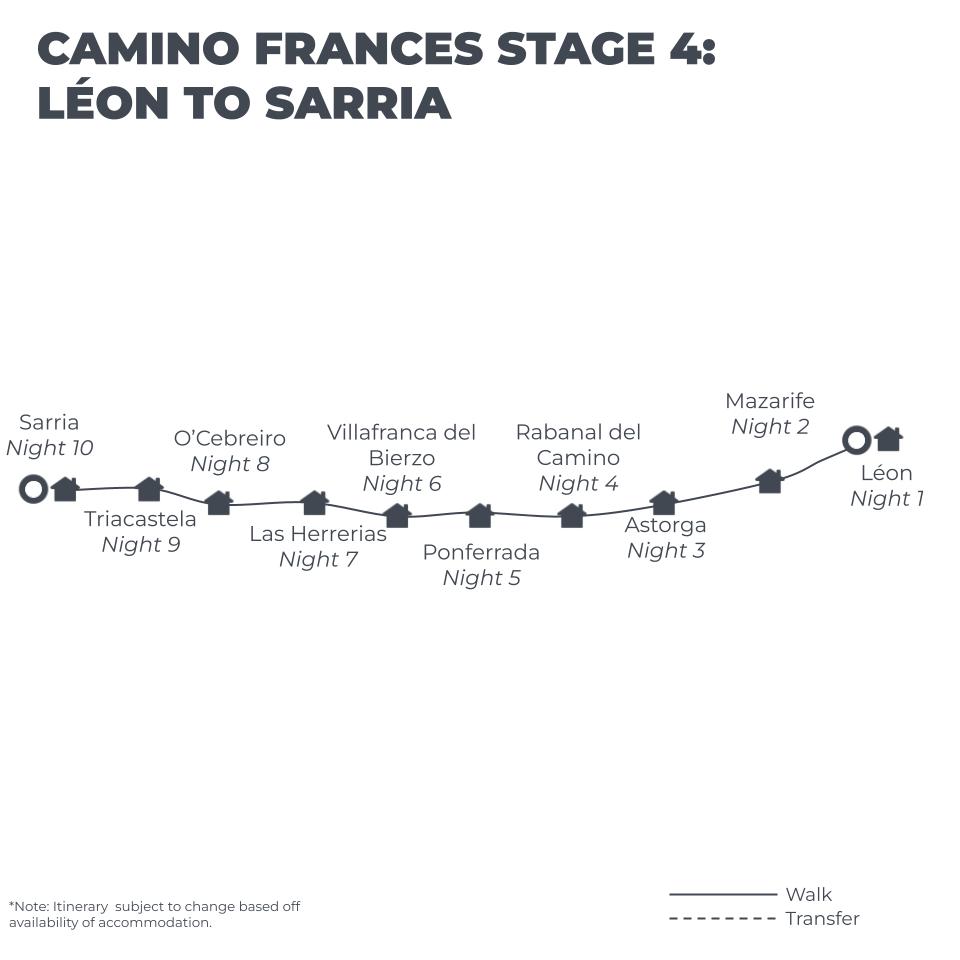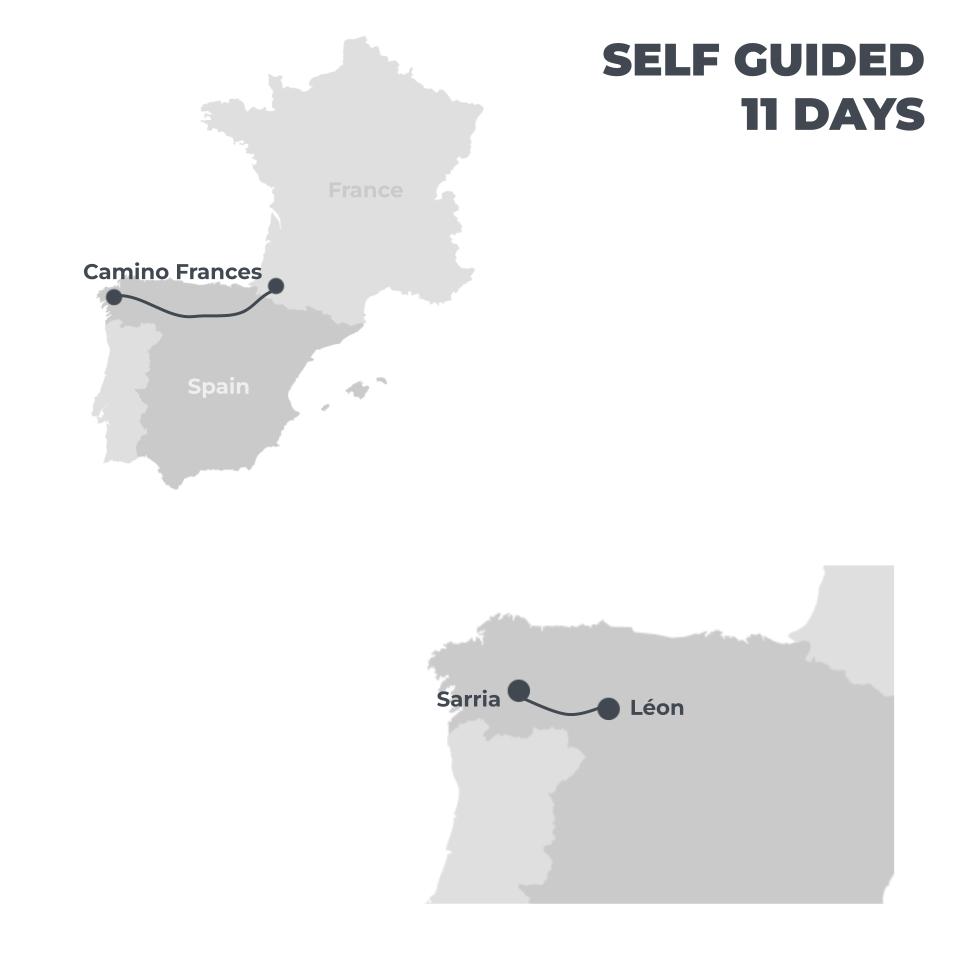
Richard F
5
Well organised and helpful staff made our first Camino walk very enjoyable.
The Camino del Norte from Gijón to Ribadeo is a stunning coastal 156 km walk with diverse landscapes and beautiful countryside. You kick things off in Gijón, a lively place with a rich maritime history the Spanish are famous for. From here the trail quickly shifts to beautiful coastal paths with sweeping views of the Cantabrian Sea. The Northern Camino winds through charming fishing villages, lush green hills, and quiet beaches, offering a peaceful and invigorating experience.
The Northern Camino passes through an assortment of towns, like Avilés, known for its historic old town and the modern Niemeyer Center, before reaching tranquil spots like Luarca, with its whitewashed houses and cosy fishing harbour, and Navia, where the green landscape and meets the massive swells and the ocean. As you near Ribadeo, you’re treated to the stunning rock formations of As Catedrais Beach. Ribadeo itself is a charming town that blends Galician and Asturian cultures, making this stretch of the Camino truly unforgettable.
 SELF GUIDED
SELF GUIDED
 10 DAYS
10 DAYS
 Easy to Moderate
Easy to Moderate 
per person twin/double share

Accommodations charge the same price per room regardless of whether there are one or two people occupying it. To cover the cost of a room when occupied by one person we need to charge the single occupancy fee.
per person

30+ Years
Camino Way
Pack Free
Eco Travel



AUTHENTIC STAYS

WITH ENSUITES

LUGGAGE TRANSFERS
PILGRIM PASSPORT
During this tour, you will stay in simple, small family-run hotels and guest houses that have been welcoming walkers of the Camino for many years. All rooms are ensuited and typically, in the style of the Camino, accommodations have a great atmosphere as the majority of other guests will be fellow walkers. As this walk is a very busy route it is usual for similar accommodations to be used other than that listed.
Single Rooms
If you are travelling with family and/or friends but would like single rooms, we would advise booking as soon as your plans are finalised to secure your rooming preferences. Single rooms incur an additional single occupancy fee.
Dining
You will be provided with breakfast each morning. If you have any food allergies or intolerances, please let us know at the time of booking so we can let your hosts know. Should you have severe food allergies, it’s always worth bringing a few of your snacks with you.
You will find many of the accommodations have their own restaurant which serves regional dishes, using local ingredients. Although dinners aren’t included in this tour, dinners can be included each evening as a supplement if you wish. Lunches can be purchased locally – a great part of the experience. You can either order lunch from your accommodation or buy local cheeses and meats along with a wide variety of different breads you will find along the Camino.
This tour is available from the start of January through to December. Regardless of when you travel, there are often celebrations along the Camino, specific to the individual towns or regions. From Asturias culture and festivals to the nationwide celebrations of Semana Santa, walking the Camino is a colourful experience.
The Camino is a well-trodden route, so the trails are very well-defined for the most part. You will follow an ancient pilgrim trail and therefore, whilst sections of the walk will take you deep into the picturesque countryside, you will also walk through urban environments and alongside roads, as you follow the truest route possible.
You should be used to walking up to 24km with up to 300m of ascent and descent. On any typical day, you will hike on rocky trails, and farm and forest tracks and cover long sections in the open countryside. You will make sustained climbs to hilltop towns, and villages and across the rolling countryside. You will also walk on some roads, so please be mindful of road users at all times.
A moderately active lifestyle makes walking enjoyable: an exercise regime of 2 to 3 times a week is needed, in addition to your usual walks. The route is very well waymarked by the iconic scallop-shell markers and with the many other walkers on the trail, it’s very easy to find your way.
For each of the walks, you will be provided with daily walk notes, a map and the GPX tracks if you wish to use them for your device.
The route runs across northern Spain and through a variety of terrain. During the early and latter part of the season, conditions can be changeable from temperate warm days through to frosty mornings and very cool nights. From May to September, rainy days are less frequent and temperatures are steadily between 20-24 degrees, however, it is possible that you may experience a few cloudy days. See weather averages here.
The tour starts in Gijon. The best way to reach Gijon is by air, arriving directly. If you are in Europe, there are many connections by train; Madrid seems to be the simplest.
From Madrid, it is around a 3.5-hour journey from the main Chamartin train station.
At the end of the trip, it might be best to travel to Santiago (3 hrs) and fly just about anywhere in Europe, Santiago to Madrid on the train is just over 3 hrs.
Or travel by bus to Lugo (2 hrs) and train it back to Madrid (5 hrs).
Going back to Gijon looks slightly shorter, but backtracking may not be something you wish to do. From Gijon, you can fly to Paris, Madrid, Barcelona, London, and Lisbon.
We require that you have adequate travel insurance against potential losses, damage or injury, including cancellation costs and loss of luggage.
For all trips that require international travel, you must have purchased travel insurance that also includes medical evacuation coverage.
We also charge a cancellation fee if you cancel your walking holiday after we have confirmed it to cover costs incurred by our suppliers and in the office. See the FAQ section for more information.
$1820
Low Season
$2030
High Season
$1890
Low Season
$2110
High Season
$1890
Low Season
$2110
High Season
$1890
Low Season
Q: What happens if I don’t want to walk one of the days, can I travel with the luggage?
Unfortunately, walkers cannot travel with the luggage. The information you are provided with has details for local taxi numbers, bus and train timetables should you wish to not walk on any day. Your accommodation hosts will also have up to date information and advice should you wish to travel to the next destination by local transport. As always, you can call us in the office should you need help during your walk.
Q: Where would you suggest adding an extra night?
We can organise this anywhere along the walk.
Q: We’re travelling as friends but would like single rooms?
Subject to a single occupancy payment, single rooms are available. However, due to the limited accommodation single rooms might not always be available for every night of the tour, but we will let you know your options throughout the booking process.
Q: Can we extend the days walked?
Of course, we’re happy to discuss your needs. If you feel you would prefer to walk into Santiago, we can add this on at a reduced cost to what is adverstised.
The Camino del Norte from Gijón to Ribadeo is a stunning coastal 156 km walk with diverse landscapes and beautiful countryside. You kick things off in Gijón, a lively place with a rich maritime history the Spanish are famous for. From here the trail quickly shifts to beautiful coastal paths with sweeping views of the Cantabrian Sea. The Northern Camino winds through charming fishing villages, lush green hills, and quiet beaches, offering a peaceful and invigorating experience.
The Northern Camino passes through an assortment of towns, like Avilés, known for its historic old town and the modern Niemeyer Center, before reaching tranquil spots like Luarca, with its whitewashed houses and cosy fishing harbour, and Navia, where the green landscape and meets the massive swells and the ocean. As you near Ribadeo, you’re treated to the stunning rock formations of As Catedrais Beach. Ribadeo itself is a charming town that blends Galician and Asturian cultures, making this stretch of the Camino truly unforgettable.
 SELF GUIDED
SELF GUIDED
 10 DAYS
10 DAYS
 Easy to Moderate
Easy to Moderate 
per person twin/double share

Accommodations charge the same price per room regardless of whether there are one or two people occupying it. To cover the cost of the accommodation when occupied by one person we need to charge the single occupancy fee.
per person

30+ Years
Camino Way
Pack Free
Eco Travel



AUTHENTIC STAYS

WITH ENSUITES

LUGGAGE TRANSFERS
PILGRIM PASSPORT
During this tour, you will stay in simple, small family-run hotels and guest houses that have been welcoming walkers of the Camino for many years. All rooms are ensuited and typically, in the style of the Camino, accommodations have a great atmosphere as the majority of other guests will be fellow walkers. As this walk is a very busy route it is usual for similar accommodations to be used other than that listed.
Single Rooms
If you are travelling with family and/or friends but would like single rooms, we would advise booking as soon as your plans are finalised to secure your rooming preferences. Single rooms incur an additional single occupancy fee.
Dining
You will be provided with breakfast each morning. If you have any food allergies or intolerances, please let us know at the time of booking so we can let your hosts know. Should you have severe food allergies, it’s always worth bringing a few of your snacks with you.
You will find many of the accommodations have their own restaurant which serves regional dishes, using local ingredients. Although dinners aren’t included in this tour, dinners can be included each evening as a supplement if you wish. Lunches can be purchased locally – a great part of the experience. You can either order lunch from your accommodation or buy local cheeses and meats along with a wide variety of different breads you will find along the Camino.
This tour is available from the start of January through to December. Regardless of when you travel, there are often celebrations along the Camino, specific to the individual towns or regions. From Asturias culture and festivals to the nationwide celebrations of Semana Santa, walking the Camino is a colourful experience.
The Camino is a well-trodden route, so the trails are very well-defined for the most part. You will follow an ancient pilgrim trail and therefore, whilst sections of the walk will take you deep into the picturesque countryside, you will also walk through urban environments and alongside roads, as you follow the truest route possible.
You should be used to walking up to 24km with up to 300m of ascent and descent. On any typical day, you will hike on rocky trails, and farm and forest tracks and cover long sections in the open countryside. You will make sustained climbs to hilltop towns, and villages and across the rolling countryside. You will also walk on some roads, so please be mindful of road users at all times.
A moderately active lifestyle makes walking enjoyable: an exercise regime of 2 to 3 times a week is needed, in addition to your usual walks. The route is very well waymarked by the iconic scallop-shell markers and with the many other walkers on the trail, it’s very easy to find your way.
For each of the walks, you will be provided with daily walk notes, a map and the GPX tracks if you wish to use them for your device.
The route runs across northern Spain and through a variety of terrain. During the early and latter part of the season, conditions can be changeable from temperate warm days through to frosty mornings and very cool nights. From May to September, rainy days are less frequent and temperatures are steadily between 20-24 degrees, however, it is possible that you may experience a few cloudy days. See weather averages here.
The tour starts in Gijon. The best way to reach Gijon is by air, arriving directly. If you are in Europe, there are many connections by train; Madrid seems to be the simplest.
From Madrid, it is around a 3.5-hour journey from the main Chamartin train station.
At the end of the trip, it might be best to travel to Santiago (3 hrs) and fly just about anywhere in Europe, Santiago to Madrid on the train is just over 3 hrs.
Or travel by bus to Lugo (2 hrs) and train it back to Madrid (5 hrs).
Going back to Gijon looks slightly shorter, but backtracking may not be something you wish to do. From Gijon, you can fly to Paris, Madrid, Barcelona, London, and Lisbon.
We require that you have adequate travel insurance against potential losses, damage or injury, including cancellation costs and loss of luggage.
For all trips that require international travel, you must have purchased travel insurance that also includes medical evacuation coverage.
We also charge a cancellation fee if you cancel your walking holiday after we have confirmed it to cover costs incurred by our suppliers and in the office. See the FAQ section for more information.
$1820
$2030
$1890
$2110
$1890
$2110
$1890
Q: What happens if I don’t want to walk one of the days, can I travel with the luggage?
Unfortunately, walkers cannot travel with the luggage. The information you are provided with has details for local taxi numbers, bus and train timetables should you wish to not walk on any day. Your accommodation hosts will also have up to date information and advice should you wish to travel to the next destination by local transport. As always, you can call us in the office should you need help during your walk.
Q: Where would you suggest adding an extra night?
We can organise this anywhere along the walk.
Q: We’re travelling as friends but would like single rooms?
Subject to a single occupancy payment, single rooms are available. However, due to the limited accommodation single rooms might not always be available for every night of the tour, but we will let you know your options throughout the booking process.
Q: Can we extend the days walked?
Of course, we’re happy to discuss your needs. If you feel you would prefer to walk into Santiago, we can add this on at a reduced cost to what is adverstised.

If you’re looking for further information on any of our walking holidays please fill out the enquiry form and we’ll be in touch.
Richard F
Well organised and helpful staff made our first Camino walk very enjoyable.
Richard G
I found Auswalk to be fully supportive and helpful in arranging my Camino. Everything went well. Pickups, hotel bookings, luggage transfers- all went perfectly. I couldn’t have expected any more – it was great
Karen K
Well organised and a ln outstanding guide made our walk unforgettable
Andrew S
Walking in Galicia was far more relaxing and accessible that walking from Aviles. Markers were more identifiable and the track itself was in wonderful condition. The weather was perfect, if it rained, it did so at night, so the walking during the day was always clear with cloudy or clear skies. Santiago was a magnificent location that I can hope to visit again. As was Madrid. Interacting with locals was always interesting, finding someone who could speak English (even a few words) was a daily challenge. The support from Tees was also wonderful. And of course, I cannot speak highly enough of Ian. His work to support me and answer questions from Spain (8-9 hours behind Australia) and keep my family informed showed his commitment to his job and the people who use Auswalks. He was a delight.